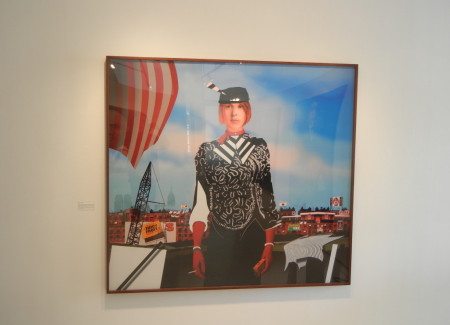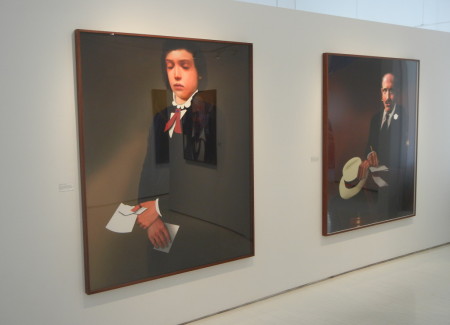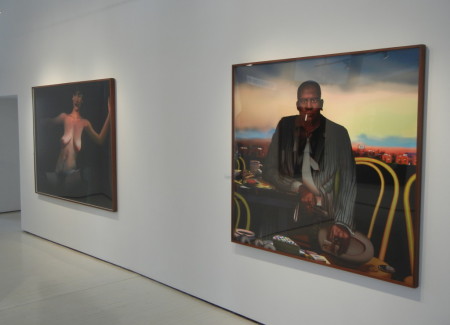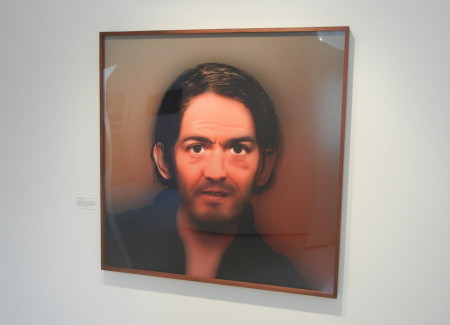JTF (just the facts): A total of 7 large scale photographic prints, framed in brown wood and unmatted, and hung against white walls in the divided gallery space. All of the works are digital c-prints, made between 2012 and 2014. Physical sizes range from 42×42 to 90×60 (or reverse), and the prints are available in editions of 3. The show also includes 1 painting, sized 84×60, from 2011. (Installation shots below.)
Comments/Context: Several years ago, the well known painter and filmmaker Alfred Leslie shocked us all by picking up a tablet computer and making hand crafted digital images that pushed the definitional boundaries of both painting and photography. Not exactly an obvious move for a successful 80+ year old artist, but one that delivered some unorthodox outcomes – here we had a painter (instead of a photographer) wrangling the controls of Photoshop, and his approach to image construction led to some unexpected visual motifs. Leslie’s newest works find him extending this unique artistic vocabulary, applying his new methods to the portraits of various literary characters.
What’s truly fascinating about these pictures is the way they mimic the pathways of imagination. When reading a description of a tragic hero, a leading lady, or a flashy secondary character in a famous novel, the words often highlight certain physical characteristics (the turn of a nose, the color of the hair, the look of the eyes, the angle of a hat), leaving the rest of the details to be filled in by the reader’s mind. Leslie’s images function in the same manner. Areas of hyper real (nearly photographic) drawing are combined with sections of blunt placeholder flatness, the compositions oscillating between detail and digital cutout, representation and mere symbolic intention.
Leslie’s interpretive portraits nearly always place primary attention on faces and hands, his painting skills giving these areas an eerie sense of reality. Skin shines, fingers curl, and eyes peer out with appropriate tactile blurs and smoothness. Often the rest of the likeness is roughed in with simpler shapes, a shirt collar or ribbon made of a flat color block, or papers held within fingers as abstract rectangles.
These contrasts give the portraits an almost puzzling vitality. Gustav von Aschenbach (from Thomas Mann’s Death in Venice) placidly sits in a chair, his balding head plausibly real, but his stubble laid in with black dots. Aging fingers grasp a cream colored fedora made of arcs of color, his white boutonniere a splash of computer perfect whiteness. Don Perlimplin (from Federico Garcia Lorca’s play) functions in the same way – penetrating eyes, but earrings that are flat circles and a shirt and sash that sit on top with a disrupting lack of depth. Hair is nearly always drawn in strand by strand with gestural computer crispness instead of the silky body and shape we might expect. Portraits of Miss Wonderly (from Dashiell Hammett’s The Maltese Falcon) and Johnny Perry (from Chester Himes mysteries) are surrounded by tiny background details, some as clues to their personalities or backstories, others as stripes, planes, and slabs of color laid in with obvious paint program shadowing or software twisting.
While we might not be able to categorize these works as photographs anymore, I think there is an important lesson about using new software tools with intention here. Leslie has made portraits that intentionally mix competing styles, creating contrasts of approach that upend our expectations – just when we think he’s giving us a beautifully executed hand, he forces it to hold something obviously digital. That back and forth, found all over each of these works, is what is exciting. While digital mark making is to be found everywhere in the current crop of newfangled abstract paintings, Leslie is incorporating it within a framework of realism, forcing the two styles to coexist. In conception, it’s not unlike what Manet did in the 19th century (introducing sketch-like abstract techniques into realistic scenes), just updated for our digital age.
Collector’s POV: The prints in this show are priced between $30000 and $50000, based on size. The painting is priced at $325000. Leslie’s photographic works have not yet reached the secondary markets, so gallery retail remains the best option for those collectors interested in following up.










